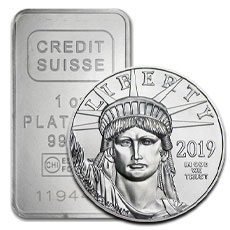| Invest in Platinum? The Bullish Case for Platinum Coins or Platinum Bars |
Scarce platinum has always been extraordinarily difficult to find. Now it is getting exceptionally difficult to extract, for a variety of reasons, once a deposit is located. Nearly three-quarters of the world’s supply of platinum metal content comes from a single country – South Africa.

The ongoing violence, labor disputes, infringed property rights, and power outages in South African mines periodically disrupt production. It is not hard to imagine even more severe problems, as history has demonstrated, creating a serious shortage and immediate spot price spike.
The events of early 2008 were likely a prelude: massive electrical blackouts shut down production at many of the country’s mines. Furthermore, rumors about a potential move by the South African government to nationalize all mines have dissuaded international mining companies from either opening or expanding production in the country.
On the demand front, platinum’s prospects are also bright. Despite the economic slowdown in many parts of the Western world, the future outlook for auto demand (and thus the demand for platinum) remains very strong thanks to a rising middle class in both China and India – where nearly 40% of the world’s population resides!
Things may change caused by interference with the Bloc countries and their option to change currency or trade dollar backing, but there is no question that these countries still have a significant amount of precious metals, including gold, silver, palladium, and platinum.
According to the United States Mint, the one-ounce American Eagle platinum coin displays the highest face value, i.e. one hundred dollars (USD $100), ever to appear on a U.S. coin. All American Eagle Coins are legal tender coins.
Although their face value is largely symbolic, it provides proof of their authenticity as official U.S. coinage that collectors find confidence in. The platinum $100 coin, with a purity of .9995, began in 1997 and continues to be produced and sold today. Just do not be sticker-shocked when you find out the US government is selling a $100 face-value coin for more than $100.
The downside risk to owning platinum coins – compared to gold coins – is currently somewhat mitigated because the metal has already seen a major drop in value relative to gold. Investors comfortable with platinum’s more speculative nature should consider diversifying a portion of their precious metals portfolio. The metal’s risk versus reward profile has rarely looked better.

